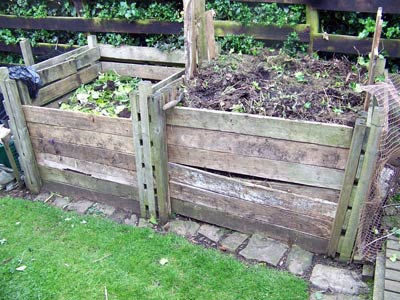Tips on Making A Compost Heap.

A compost heap is an excellent way of recycling dead plant material and generating the best possible soil fertiliser. A good compost heap also gives a feeling of satisfaction because it helps the gardener to become part of the natural cycle of growth, decay and regeneration. Using a compost heap will also save many unnecessary trips to the local tip. See also: Benefits of Composting
How To Make a Good Compost Heap
The Compost Bin A compost bin should be about 1 square metre. It is important to have a good size, but, it should also be compact because otherwise the generated heat will be dissipated. It is also best to have at least two bins. This enables one heap to rot down, whilst the other is added to. A compost heap should also be aerated and enable water to enter. If you have an enclosed plastic bin, make sure you water where necessary.
Positioning. A compost heap can be really be put anywhere; most people want to choose a spot that is not too prominent. However, if it receives direct sunlight the process of decomposition will be faster.
Base Layer. At the bottom of a compost heap it is good to use some twiggy material to make sure there is good drainage; if you have a heavy clay soil, you might want to add some grit to provide good drainage. If a compost heap becomes waterlogged, the process of decomposition will slow down and it will become slimy.
Mixing Layers. The next important strategy is to provide a good mix of material when building up a compost heap. For example, grass is a high source of nitrogen and can break down quickly to generate heat. However, grass needs to be mixed with other more woody material, otherwise it will not rot down properly. Similarly on their own stems and twigs will take a long time to rot down unless they have an activator like grass or over very green material. When adding grass clippings spread them out to form a thin, equal layer; then add a layer of more twiggy material. If necessary store a potential layer for adding at the right time.
Breaking Up Twiggy Material. Thick stems will take a long time to break down. If you have a shredder, it will make the job of composting a lot more successful. It will break down the material and enable much faster composting. If you don’t have a shredder, you can just squash the stems or break them in a few places. A rather crude, but effective, tip is to get a spade and hit down on the top of the heap to break a few stems. Even this small step will help quite a lot; what you are doing is to increase the surface area, enabling faster decomposition.
Water. As mentioned before, water is important. It is important to water a compost heap a bit like watering a plant. If there is no water, the compost heap will dry out and will not decompose. If it is waterlogged it will stagnate. Most compost heaps suffer from being dry, so every now and then throw on some water to speed up the process of decomposition.
Cover. When the compost heap is finished with adequate amounts of water, it is good to cover with a plastic coating. This enable the heap to generate more heat, speeding up the process of decomposition; it also prevents excess water.
Aerate. In hot weather when a compost heap is generating a lot of heat it is a good idea to get a garden cane and poke the heap, every now and then. This allows air to enter and expedites the process of aerobic decomposition. A good heap will have steam coming from it when you aerate it.
What to Avoid in a Compost Heap
- Avoid thick branches and twigs. As a general rule, avoid anything thicker than a finger.
- Cooked meat and other food. This can attract rats and other vermin. Unless it is completely secured it is not worth it
- Anything plastic
- Be wary of adding sharp thorns when you come to distribute the heap, hopefully, they will have disintegrated but not necessarily.
- Leaves. Leaves take a lot time to decompose and should be separated.
How Long Does a Compost Heap Take?
In summer, if a heap is built with the right mix of materials a compost heap can decompose in 3-6 months. In winter, the process will be much slower and may take 6-9 months. If a heap is badly built, it could take over 12 months.
It doesn’t matter if the compost heap is not entirely rotted down. The important thing is that good compost should have a sweet smell and look dark and rich; if you can still see some half decomposed stems that doesn’t matter because they will break down separately.
Books on compost heaps at Amazon UK
8 thoughts on “Tips on Making A Compost Heap.”
I turn my heap every spring and autumn. I take the bottom third, screen it thru a 6mm screen then mix the screens back with the rest and restack, adding garotta every 6 inches
One thing missing from your list of ingredients is paper from the ever mounting pile of shredded letters,bank statements and rude things printed from the internet etc the worms seem to love these and they get dragged down quickly…..
Comments are closed.